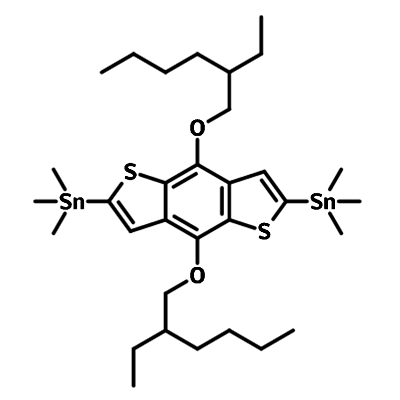BDTOEHSn
CAS Number 1160823-78-8
Chemistry Building Blocks, Heterocyclic Building Blocks, Materials, Monomers, Organotin CompoundsBDTOEHSn, for the synthesis of low bandgap semiconducting polymers
High quality and high purity monomer available online
Specifications | MSDS | Literature and Reviews
4,8-Bis[(2-ethylhexyl)oxy]-2,6-bis(trimethylstannyl)benzo[1,2-b:4,5-b']dithiophene (BDTOEHSn), CAS number 1160823-78-8, is the intermediate for the synthesis of low bandgap semiconducting polymers such as PTB7 and PBDTTPD. Ethylhexyl side chains can help to promote stability and solubility of the target structure or polymer.
Benzo[1,2-b:4,5-b']dithiophene (BDT) is one of the widely used building blocks to produce polymer structures for highly efficient organic solar cells, in a blend with fullerene or non-fullerene acceptors.
General Information
| CAS Number | 1160823-78-8 |
| Chemical Formula | C32H54O2S2Sn2 |
| Molecular Weight | 772.32 g/mol |
| Full Name | 4,8-Bis[(2-ethylhexyl)oxy]-2,6-bis(trimethylstannyl)benzo[1,2-b:4,5-b']dithiophene |
| Synonyms | 2,6-Bis(trimethyltin)-4,8-bis(2-ethylhexyloxy)benzo[1,2-b:4,5-b′]dithiophene; 1,1′-[4,8-Bis[(2-ethylhexyl)oxy]benzo[1,2-b:4,5-b′]dithiophene-2,6-diyl]bis[1,1,1-trimethyl]stannane |
| Classification / Family | Benzodithiophene (BDT) derivatives, Organic semiconducting materials, Semiconductor Synthesis, Low band gap polymers, Organic Photovoltaics. |
Chemical Structure

Product Details
| Purity | >98% |
| Melting Point | 70-75 °C |
| Appearance | White crystals/powder |
MSDS Documentation
Literature and Reviews
- Improving the long-term stability of PBDTTPD polymer solar cells through material purification aimed at removing organic impurities, W. Mateker et al., Energy Environ. Sci., 6, 2529 (2013); DOI: 10.1039/c3ee41328d.
- Interplay Between Side Chain Pattern, Polymer Aggregation, and Charge Carrier Dynamics in PBDTTPD:PCBM Bulk-Heterojunction Solar Cells, C. Dyer-Smith et al., Adv. Energy Mater., 5(9), 1401778 (2015); doi: 10.1002/aenm.201401778.
- Absolute Measurement of Domain Composition and Nanoscale Size Distribution Explains Performance in PTB7:PC71BM Solar Cells, B. Collins et al., Adv. Energy Mater., 3(1), 1200377 (2013); DOI:10.1002/aenm.201200377.

 BDTOEHSn MSDS sheet
BDTOEHSn MSDS sheet